Papers by Anna Maria Papini
Giornale Italiano di Dermatologia e Venereologia

Analytical and Bioanalytical Chemistry, 2015
Adalimumab (ADA) is a TNF-α blocker drug antibody fully humanized and thus indistinguishable in s... more Adalimumab (ADA) is a TNF-α blocker drug antibody fully humanized and thus indistinguishable in structure and function from natural human IgG1, used in the juvenile idiopathic arthritis (JIA) treatment. Immunogenicity against the drug has been frequently detected in treated patients, and the presence of anti-ADA antibodies is correlated to treatment failure or lower clinical remission. Herein, we measured by surface plasmon resonance (SPR) both the binding and the affinity of anti-ADA antibodies to the ADA-immobilized biosensor. The binding of anti-ADA antibodies was evaluated by testing sera from ADA-treated patients (n = 30), untreated patients (n = 9), and healthy donors (n = 20) in the SPR biosensor. The optimal cut-off point was defined using the receiver operating characteristic curve (ROC-curve) analysis with 79 % (60.28 to 92.01 %, 95 % CI) sensitivity, 99 % (88.06 to 100.0 %, 95 % CI) specificity, and a positive likelihood ratio of 23. The area under the curve was 0.9298 (p < 0.0001). The apparent affinity of anti-ADA antibodies from pediatric patients' sera was measured, analyzing the interaction of anti-drug antibodies using whole sera, enriched IgG fractions, and isolated anti-ADA antibodies. The immobilized drug ADA interacted with purified antibodies at low affinities (10(-6) M > K D > 10(-9) M). Graphical Abstract Adalimumab immobilized on the biosensor chip surface detects specific anti-drug antibodies in treated patients' sera.

Journal of Peptide Science, 2013
The detection of reactivity against autoantigens plays a crucial role in the diagnosis of autoimm... more The detection of reactivity against autoantigens plays a crucial role in the diagnosis of autoimmune diseases. However, only a few autoantibodies are known in each disease, and their precise targets are often not precisely defined. In neuromyelitis optica (NMO), an autoimmune disease of the central nervous system, anti-aquaporin 4 antibodies are currently the only available immunological markers, although they are not detected in 10-50% of patients. Using enzyme-linked immunosorbent assays, we evaluated the reactivity against 19 structurally defined peptides in 26 NMO sera compared with 21 healthy subjects. We observed increased levels of IgG against myelin basic protein sequence MBP(156-175), pyruvate dehydrogenase sequence PDH(167-186) and CSF114(Glc), the last of these having a possible correlation with onset of inflammatory relapse. These preliminary results may suggest that the aquaporin 4 is not the unique target in NMO and that the study of reactivity against these peptides would be helpful for the diagnosis and follow-up of the disease. Complementary studies are however warranted to confirm these results.

International Journal of Molecular Sciences
Members of neuropeptide B/W signaling system have been predominantly detected and mapped within t... more Members of neuropeptide B/W signaling system have been predominantly detected and mapped within the CNS. In the rat, this system includes neuropeptide B (NPB), neuropeptide W (NPW) and their specific receptor NPBWR1. This signaling system has a wide spectrum of functions including a role in modulation of inflammatory pain and neuroendocrine functions. Expression of NPB, NPW and NPBWR1 in separate heart compartments, dorsal root ganglia (DRG) and stellate ganglia was proven by RT-qPCR, Western blot (WB) and immunofluorescence. Presence of mRNA for all tested genes was detected within all heart compartments and ganglia. The presence of proteins preproNPB, preproNPW and NPBWR1 was confirmed in all the chambers of heart by WB. Expression of preproNPW and preproNPB was proven in cardiac ganglionic cells obtained by laser capture microdissection. In immunofluorescence analysis, NPB immunoreactivity was detected in nerve fibers, some nerve cell bodies and smooth muscle within heart and bot...
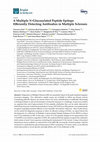
Brain Sciences
Diagnostics of Multiple Sclerosis (MS) are essentially based on the gold standard magnetic resona... more Diagnostics of Multiple Sclerosis (MS) are essentially based on the gold standard magnetic resonance imaging. Few alternative simple assays are available to follow up disease activity. Considering that the disease can remain elusive for years, identification of antibodies fluctuating in biological fluids as relevant biomarkers of immune response is a challenge. In previous studies, we reported that anti-N-glucosylated (N-Glc) peptide antibodies that can be easily detected in Solid-Phase Enzyme-Linked ImmunoSorbent Assays (SP-ELISA) on MS patients’ sera preferentially recognize hyperglucosylated adhesin of non-typeable Haemophilus Influenzae. Since multivalency can be useful for diagnostic purposes to allow an efficient coating in ELISA, we report herein the development of a collection of Multiple N-glucosylated Peptide Epitopes (N-Glc MEPs) to detect anti-N-Glc antibodies in MS. To this aim, a series of N-Glc peptide antigens to be represented in the N-GlcMEPs were tested in competi...
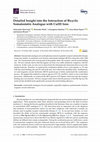
International Journal of Molecular Sciences
Somatostatin analogues are useful pharmaceuticals in peptide receptor radionuclide therapy. In pr... more Somatostatin analogues are useful pharmaceuticals in peptide receptor radionuclide therapy. In previous studies, we analyzed a new bicyclic somatostatin analogue (BCS) in connection with Cu(II) ions. Two characteristic sites were present in the peptide chain: the receptor- and the metal-binding site. We have already shown that this ligand can form very stable imidazole complexes with the metal ion. In this work, our aim was to characterize the intramolecular interaction that occurs in the peptide molecule. Therefore, we analyzed the coordination abilities of two cyclic ligands, i.e., P1 only with the metal binding site and P2 with both sites, but without the disulfide bond. Furthermore, we used magnetic circular dichroism (MCD) spectroscopy to better understand the coordination process. We applied this method to analyze spectra of P1, P2, and BCS, which we have described previously. Additionally, we analyzed the MCD spectra of P3 ligand, which has only the receptor binding site in i...
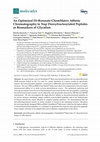
Molecules
We report herein a novel ChemMatrix® Rink resin functionalised with two phenylboronate (PhB) moie... more We report herein a novel ChemMatrix® Rink resin functionalised with two phenylboronate (PhB) moieties linked on the N-α and N-ε amino functions of a lysine residue to specifically capture deoxyfructosylated peptides, compared to differently glycosylated peptides in complex mixtures. The new PhB-Lys(PhB)-ChemMatrix® Rink resin allows for exploitation of the previously demonstrated ability of cis diols to form phenylboronic esters. The optimised capturing and cleavage procedure from the novel functionalised resin showed that only the peptides containing deoxyfructosyl-lysine moieties can be efficiently and specifically detected by HR-MS and MS/MS experiments. We also investigated the high-selective affinity to deoxyfructosylated peptides in an ad hoc mixture containing unique synthetic non-modified peptides and in the hydrolysates of human and bovine serum albumin as complex peptide mixtures. We demonstrated that the deoxyfructopyranosyl moiety on lysine residues is crucial in the cap...
Journal of Peptide Science
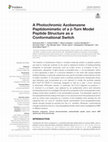
Frontiers in Chemistry
The insertion of azobenzene moiety in complex molecular protein or peptide systems can lead to mo... more The insertion of azobenzene moiety in complex molecular protein or peptide systems can lead to molecular switches to be used to determine kinetics of folding/unfolding properties of secondary structures, such as α-helix, β-turn, or β-hairpin. In fact, in azobenzene, absorption of light induces a reversible trans ↔ cis isomerization, which in turns generates a strain or a structure relaxation in the chain that causes peptide folding/unfolding. In particular azobenzene may permit reversible conformational control of hairpin formation. In the present work a synthetic photochromic azobenzene amino acid derivative was incorporated as a turn element to modify the synthetic peptide [Pro 7 ,Asn 8 ,Thr 10 ]CSF114 previously designed to fold as a type I β-turn structure in biomimetic HFA/water solution. In particular, the P-N-H fragment at positions 7-9, involved in a β-hairpin, was replaced by an azobenzene amino acid derivative (synthesized ad hoc) to investigate if the electronic properties of the novel peptidomimetic analog could induce variations in the isomerization process. The absorption spectra of the azopeptidomimetic analog of the type I β-turn structure and of the azobenzene amino acid as control were measured as a function of the irradiation time exciting into the respective first ππ * and nπ * transition bands. Isomerization of the azopeptidomimetic results strongly favored by exciting into the ππ * transition. Moreover, conformational changes induced by the cis↔ trans azopeptidomimetic switch were investigated by NMR in different solvents.
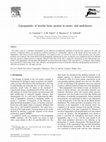
Thin Solid Films
We report a part of a systematic investigation on the behaviour of lipopeptide analogues of myeli... more We report a part of a systematic investigation on the behaviour of lipopeptide analogues of myelin basic protein at the water-air interface. A palmitoyl moiety was introduced in different positions of a nonapeptide sequence of the human myelin basic protein. The lipopeptides, either alone or mixed with phospholipids, were studied at water-air interface by means of surface pressure-area and surface potential-area isotherms. The results deduced for the lipopeptide conformation at water-air interface were compared to the results obtained from the structural characterisation of Langmuir-Blodgett (LB) films of the above compounds. Information on the bidimensional miscibility of the lipopeptides with membrane phospholipids was deduced from the analysis of the experimental p-A isotherms. These findings were correlated to clinical trials of the same substances and interpreted in terms of molecular interaction and lipopeptide conformation.
Frontiers in chemistry, 2017
In vivo somatostatin receptor scintigraphy is a valuable method for the visualization of human en... more In vivo somatostatin receptor scintigraphy is a valuable method for the visualization of human endocrine tumors and their metastases. In fact, peptide ligands of somatostatin receptors (sst's) conjugated with chelating agents are in clinical use. We have recently developed octreotide dicarba-analogs, which show interesting binding profiles at sst's. In this context, it was mandatory to explore the possibility that our analogs could maintain their activity also upon conjugation with DOTA. In this paper, we report and discuss the synthesis, binding affinity and conformational preferences of three DOTA-conjugated dicarba-analogs of octreotide. Interestingly, two conjugated analogs exhibited nanomolar affinities on sst2 and sst5 somatostatin receptor subtypes.

Journal of Medicinal Chemistry, Aug 1, 2001
Myelin oligodendrocyte glycoprotein (MOG), a minor myelin component, is an important central nerv... more Myelin oligodendrocyte glycoprotein (MOG), a minor myelin component, is an important central nervous system specific target autoantigen for primary demyelination in autoimmune diseases such as multiple sclerosis (MS). The native structure of MOG presents a glycosylation site at position 31 (Asn(31)). It has been recently described that glycosylation of a MOG peptide epitope improved the detection of specific autoantibodies in sera of MS patients. The solution conformational behavior of two MOG derived peptides-hMOG(30-50) (1) and the glycosylated analogue [Asn(31)(N-beta-Glc)]hMOG(30-50) (2)-were investigated through NMR analysis in a water/HFA solution. Conformational studies revealed that peptides 1 and 2 adopted similar conformations in this environment. In particular, they showed strong propensity to assume a well-defined amphipatic structure encompassing residues 41-48. The N-terminal region resulted to be almost completely unstructured for both peptides. The presence in 1 of a low populated Asx-turn conformation characteristic of the Asn-Xaa-Thr glycosylation sites was the only conformational difference between peptides 1 and 2. Thus, the specific antibody recognition of peptide 2 is most likely driven by direct interactions of the antibody binding site with the Asn-linked sugar moiety.
Cheminform, 2010
ABSTRACT Alkylation of the anion of the title compound with iodomethane, benzylbromide, or allyl ... more ABSTRACT Alkylation of the anion of the title compound with iodomethane, benzylbromide, or allyl bromide proceeds in a highly diastereoselective fashion to afford tricarbonyl(2S*,3R* methyl 2-substituted-3,5-hexadienoate) iron complexes. The relative stereochemistry of the methylation product 2a was determined by single X-ray crystallographic analysis of the corresponding diastereomeric carboxylic acid 4b.
Tetrahedron, Apr 1, 2004
A new reaction of oxazolines derived from serine with diethyl phosphite leading to ring opening p... more A new reaction of oxazolines derived from serine with diethyl phosphite leading to ring opening products with P–C bond formation is reported. This reaction, which proceeds under neutral conditions and without the use of any halogenated intermediate, results in a mixture of racemic α- and β-phosphono alanines in an approximate 1:2 ratio, with isolated yields up to 77%. The mechanism
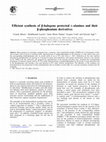
Tetrahedron Asymmetry, 2003
Ring opening of oxazolines, prepared from L-serinates, with trimethylsilyl halides (TMSX) led to ... more Ring opening of oxazolines, prepared from L-serinates, with trimethylsilyl halides (TMSX) led to b-halogeno-N-benzoyl-a-amino esters in good to excellent yields. Quaternization of triphenylphosphine by the b-bromo or-iodo amino esters gave the corresponding b-phosphonium salts in overall yields of up to 93% and with e.e. >96%. Hydrolysis of the ester function afforded the phosphonium salt bearing an N-benzoyl-a-amino acid substituent, with partial racemization. However, the reaction of the TMSX with the carboxylic salt, prepared by saponification of the starting oxazoline ester, furnished the corresponding b-halogeno-N-benzoyl-a-amino acids in 70-95% yields. Quaternization of triphenylphosphine by the bromo or iodo derivatives led to the phosphonium salts bearing a free acid function in 95% yield, without racemization. The efficiency of this synthesis was demonstrated by the preparation of these phosphonium salts in excellent overall yields, by a one-pot procedure starting from the oxazoline.








Uploads
Papers by Anna Maria Papini